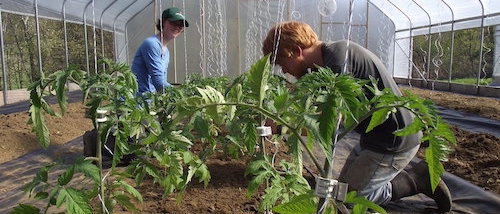Once you get over the fear it can save lots of time
When I first saw tine weeders more than 25 years ago, I couldn’t really understand how they worked. A tine weeder is essentially a rake, and I often do use rakes as tine weeders on my tiny farm. The first tine weeder I used was a modification of a Lely tine weeder (similar to a Williams Tool) which was set up behind a tractor. Through extensive use of that, and similar tine weeders I’ve gained a better understanding of both how they work, and where and when they make sense.

A demonstration of the Tiny Treffler tine weeder blind cultivating young brassica transplants. I originally met the owners of this company when they were selling much larger tractor versions (up to 60’ wide!) but I’ve been impressed at the quality of their small-scale offerings in the years since.
There was an excellent article on Japanese farm tours in the August 2024 GFM with a couple of photos of a tine weeder called a Hawking and some excellent images explaining some of the basics of how a tine weeder works. Importantly, a tine weeder is most effective on weeds that have just germinated but may not have even broken the soil surface yet (thread stage).

Treffler has started making a lighter-weight aluminum framed model for farmers who are hand pulling. With this side view you can see that the tines are set to drag through the soil nearly vertically. They are spring loaded with independent adjustment of both the spring tension and the height of the frame. Those two adjustments determine the angle that the tines enter the soil and the depth that they work, making allowances for different soil and crop conditions.
It can also be effective on small weeds that have broken the surface, but as the weeds get larger it becomes less and less effective. For this reason tine weeders are often used “blind,” meaning they run right over the crop row when crop seedlings are still relatively small, disrupting germinating weeds that are right in the row with the crop as well as the ones between the rows, but leaving the slightly larger crop seedlings mostly undamaged.
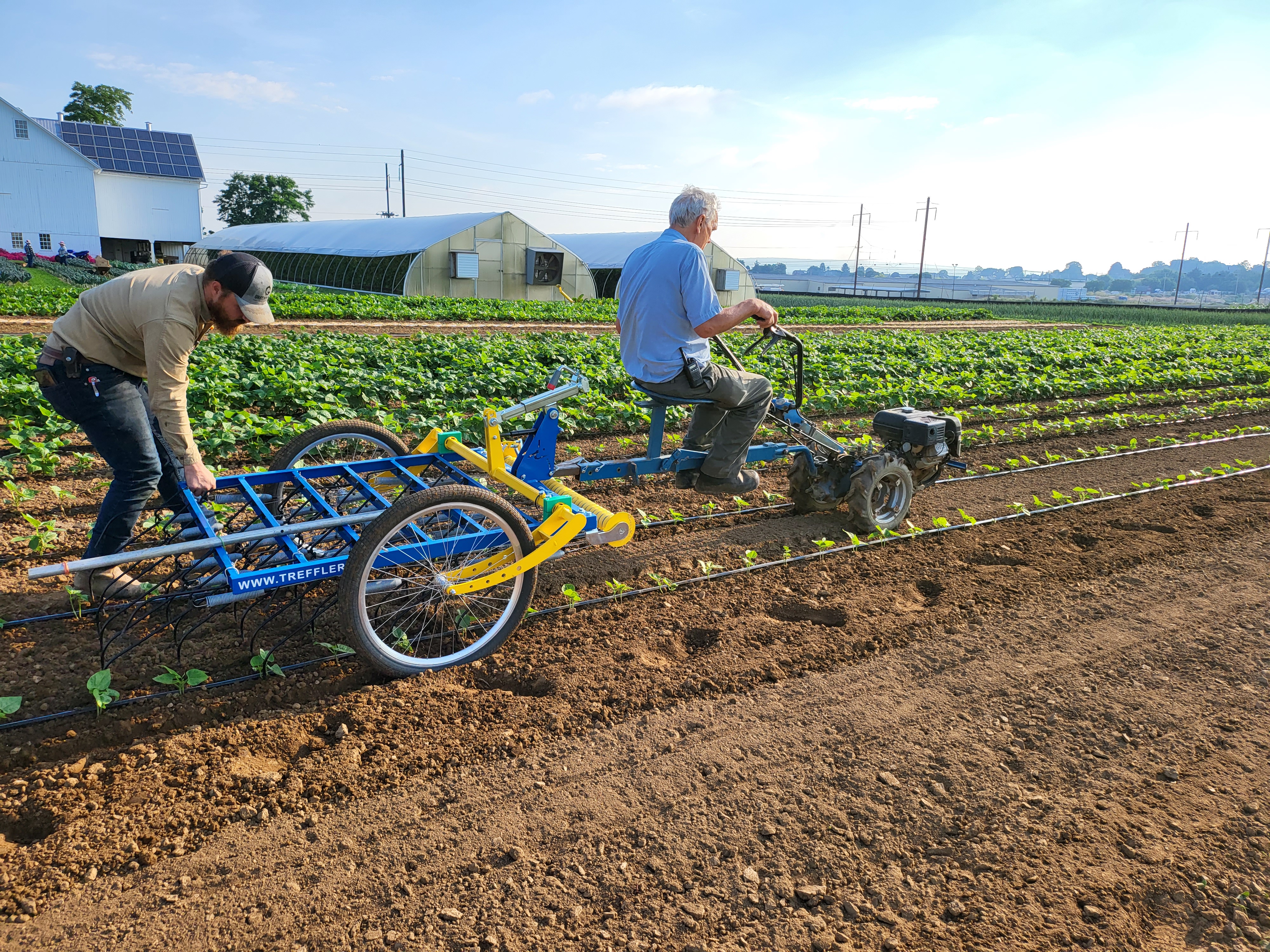
The Tiny Treffler can also be pulled by a four- or two-wheel tractor, as in the photo. Although they can both be tractor mounted, the TT is a lighter version and the TS is a sturdier version with more durable features.
I do occasionally use tine weeders for blind weeding, and it still a scary thing for me to do. If the crop isn’t well rooted enough, it can drag the crop plant out, and if the crop is too large it can snag the tops, breaking off leaves and stems, which is not ideal. As with everything there is a learning curve where you’re figuring out what is too small and what is too big, and of course it varies with crop type, soil and weather conditions, but if you’re bold enough to try it you’ll be surprised at how effective it can be and how much abuse the crop plants can take from the tines with no long term negative consequences.
More often I just using tine weeders between rows. That is partly because the type of tine weeder I usually use is more aggressive, and partly because I’m often tine weeding before the crop is large enough to not be uprooted, or after the crop is too large to avoid damage to the leaves and stems.
The way I think about how a tine works on weeds is by three mechanisms. First, it will drag out poorly rooted weed seedlings, often leaving them either on top to dry out, or in a loose, dry soil layer near the top of the soil profile. Sometimes they’ll re-root in place, but they’ve at least been set back and are more susceptible to a second pass a week later, or with a different tool.
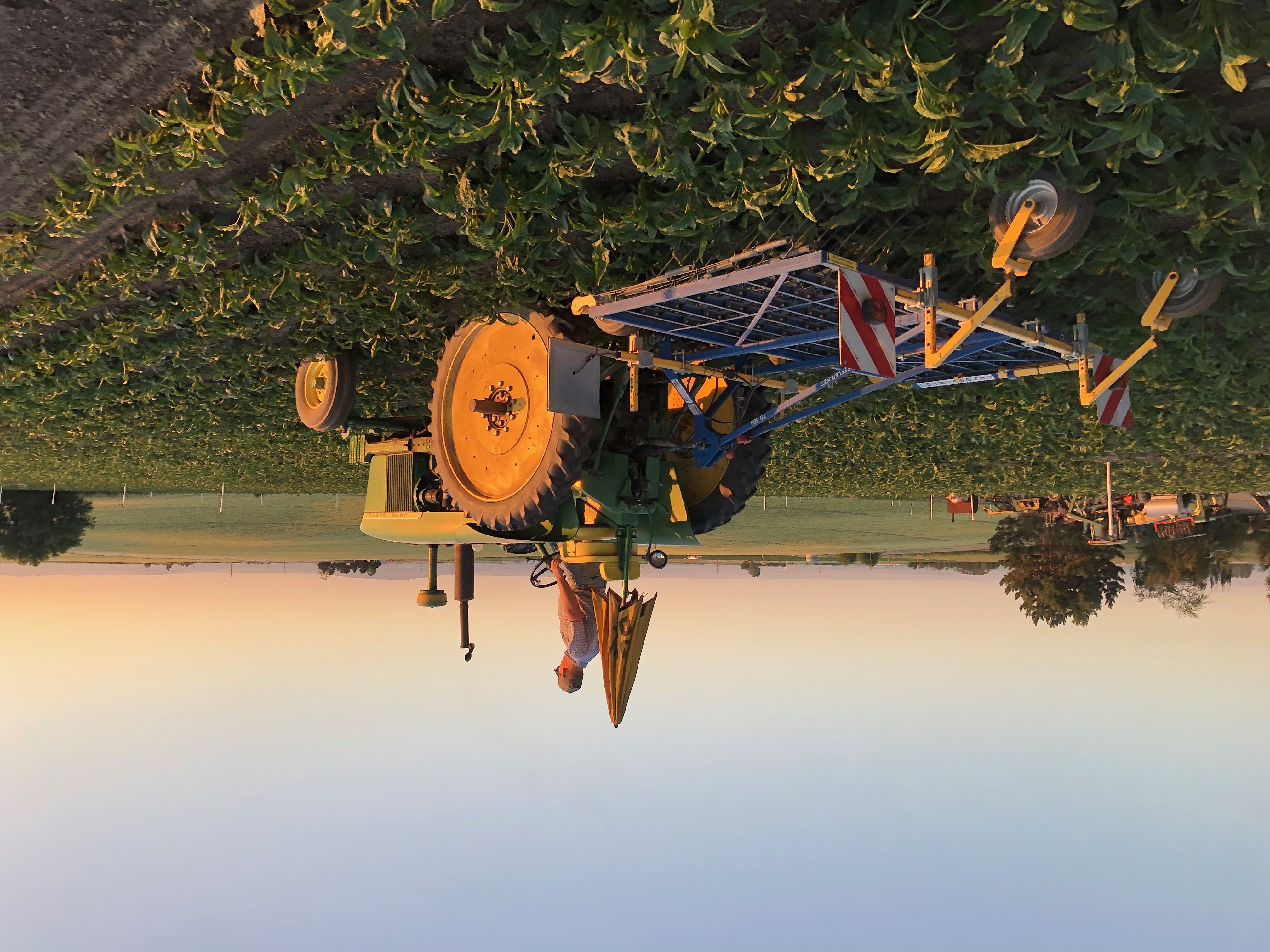
They make larger versions of the tine weeder that are designed exclusively for use behind tractors.
Second, the tines loosen and open the surface soil. This can kill weeds germinating near the surface by drying out that soil and breaking capillary action that brings up any significant moisture from lower in the soil profile (the opposite of the press wheel on the back of a seed drill which helps encourage capillary action to keep seeds moist). Not only does this help kill weeds (or at least set them back) it allows better water and air infiltration which is good for the crops and reduces crusting problems that can cause trouble for other types of cultivating tools that might be used later. Third, as the tines stir up and loosen the soil they inevitably bury some of the smallest weeds, creating a physical barrier that again either kills or sets back whatever weeds have just germinated.
There are a number of other reasons I also like tine weeders: They are light weight, require relatively low power, and work best at higher speeds which makes them excellent choices for covering large amounts of ground quickly, and for use on small farms that either have a very small tractor or no tractor at all. They are relatively simple mechanically so there’s not a lot to adjust or repair so they are very low maintenance. They also tend to work better than other mechanical cultivation tools when the soil is wetter than ideal, a situation we experience here in the Pacific Northwest for most of the planting season.

On the left you can see the aftereffects of running a Johnny’s Tine Weeder rake directly over fall planted green onions. There are still quite a few small weeds, but significantly fewer than in the row on the right and the surface crust has been broken which improves conditions for future cultivations. This was a quick pass in wet soil conditions that would have been incredibly challenging with a hoe.
In soils that are wetter than ideal the tines have less of a tendency to clog and smear soil than other tools I’ve used. If the tines are spring loaded, which is common with many designs, the vibration as they are moving through the soil helps shake soil and other debris off. Even with fixed tines, that don’t vibrate, the smaller tine profiles and near vertical orientation don’t collect as much soil and debris as the horizontal surfaces on hoe blades or tractor sweeps and knives.
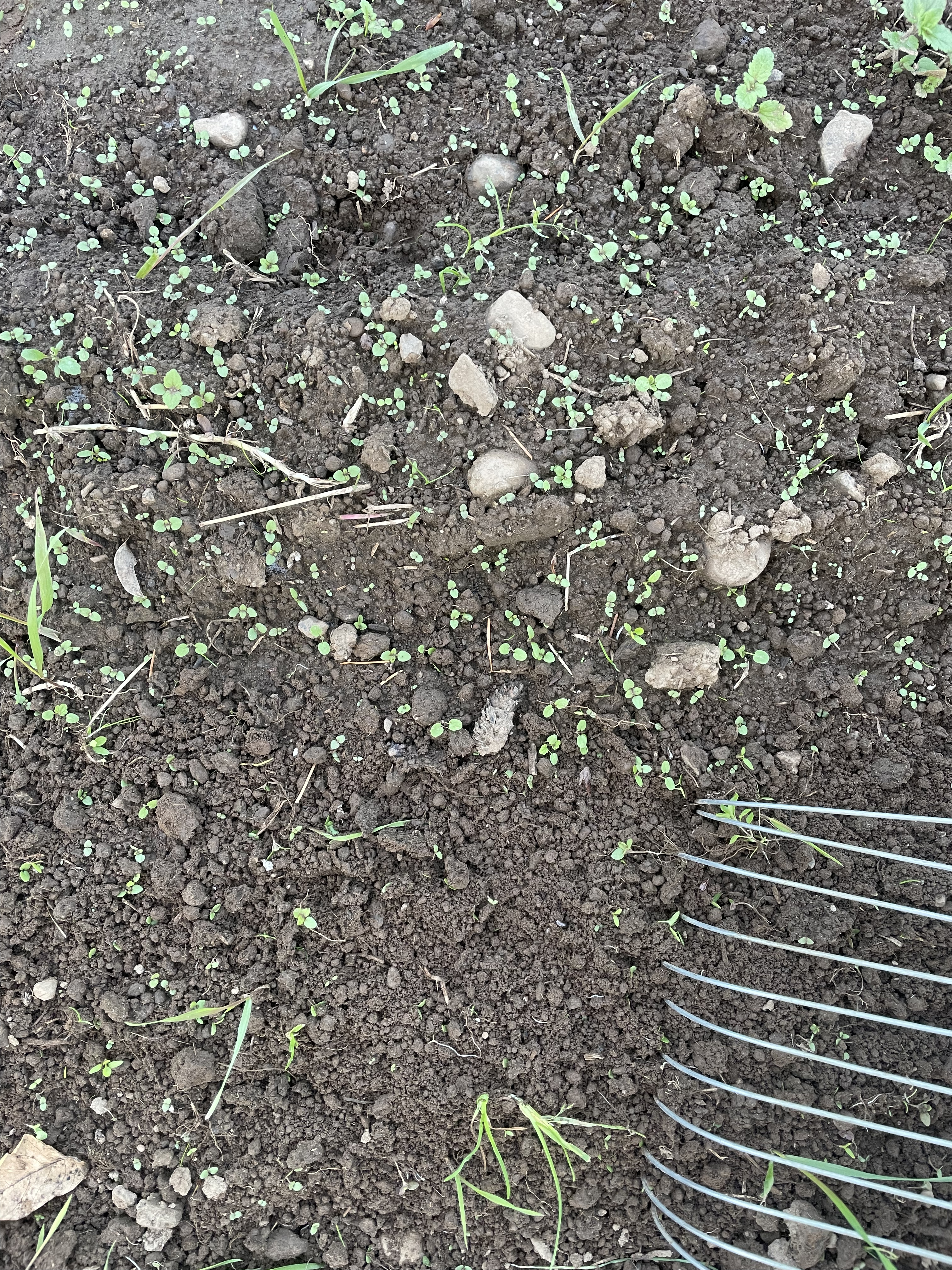
The soil in the bottom half of this photo had one quick pass with the Johnny’s Tine Weeding Rake.
Another design feature which isn’t immediately obvious is the benefit of having multiple rows of widely spaced tines, as opposed to a single row of more closely spaced tines. This makes the tool longer, which isn’t ideal in tight spaces, but the wider spacing within a row prevents soil and debris from bridging between the tines and clogging. A regular garden rake is a great tine weeder in ideal conditions but the relatively close spacing between tines means it’s more likely to clog and that’s bad because it means that soil isn’t just loosened it starts dragging the soil, and dragging it over larger plants, like the crop plants. That said, on the hand scale I often use rakes as tine weeders with single rows because they’re easier to handle and more readily available.
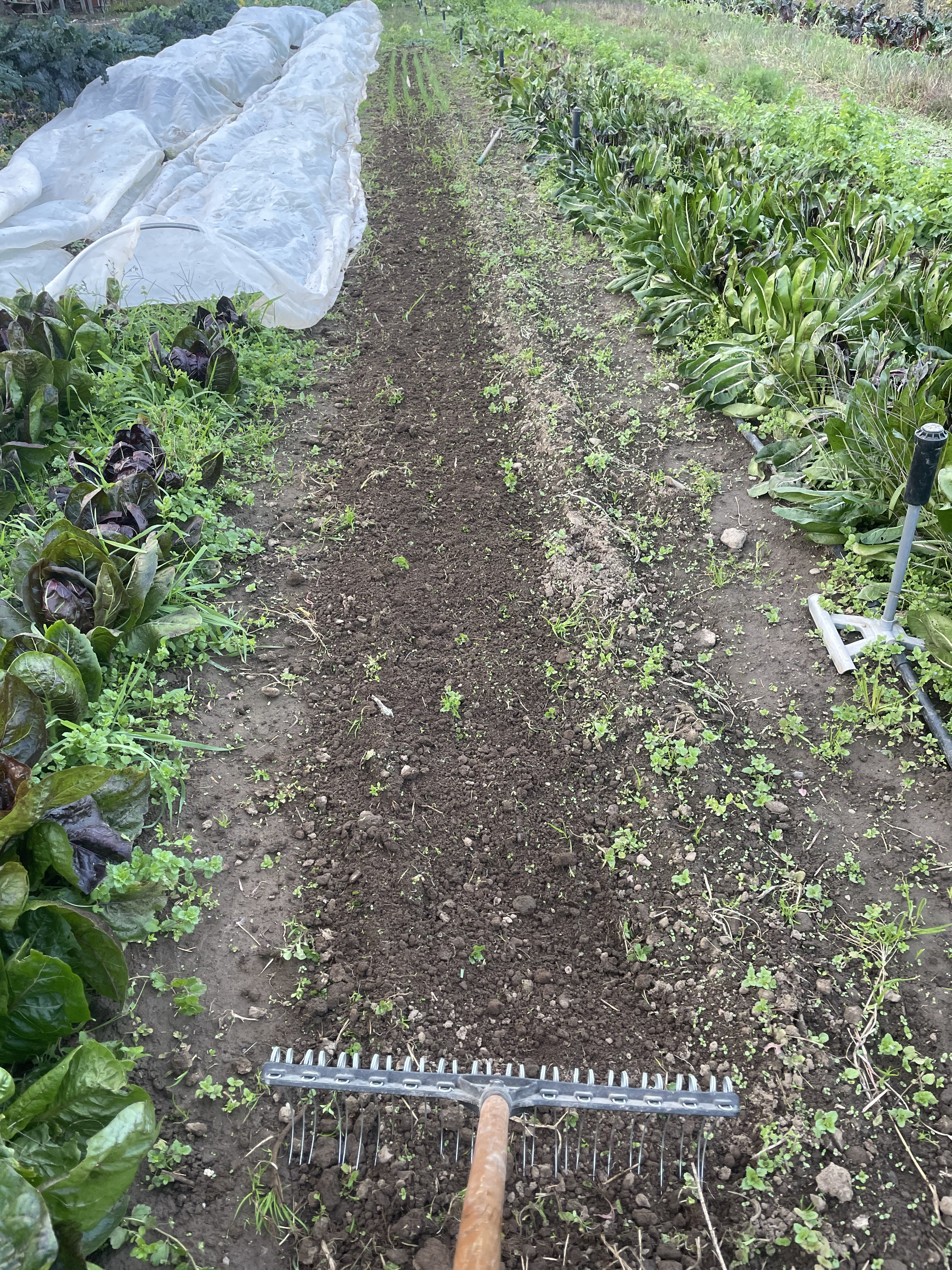
Blind cultivation of fall planted French gray shallots. As long as the tines don’t penetrate below the shallot sets they won’t pull them up but they will loosen the soil surface and take out the smallest weeds. The soil on the right has not been raked and shows what the soil looked like before the rake pass.
As with any tool there are also a number of limitations to tine weeders. The obvious limitation is that they’re only really effective when weeds are just germinating, and even at that they will always miss a portion of the weeds making it necessary to combine them with other tools. They can also be more challenging to use in heavy, tight soils where the tines may not be strong enough to penetrate the surface sufficiently. In rocky soils my experience is that they work well in the sense that the spring-loaded tine weeders will mostly just go around the rocks, but that also means they’ll tend to miss weeds that are sheltering behind rocks, but then again most mechanical tools are a challenge in rocky conditions.
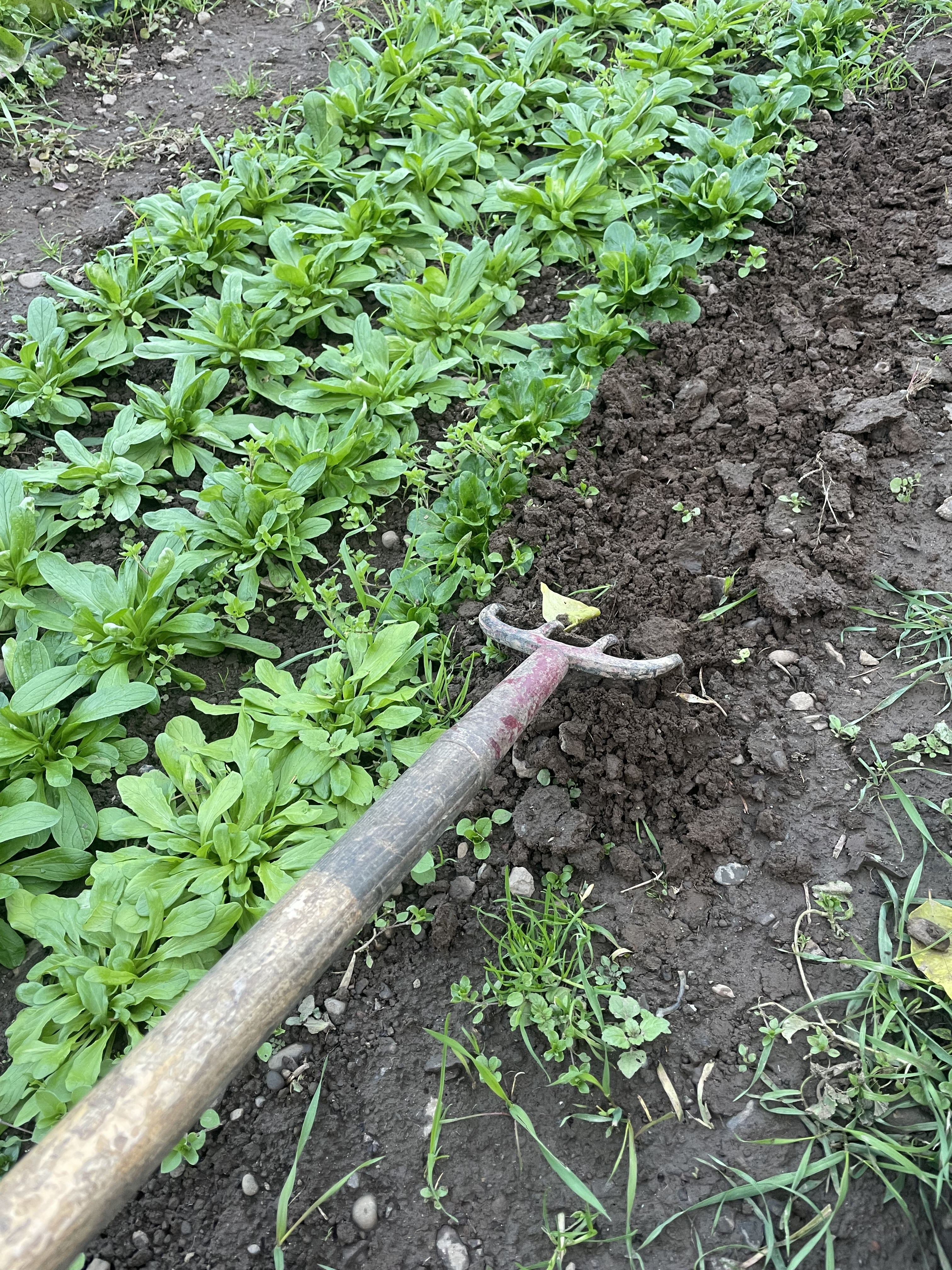
Another type of tine weeder we use frequently in the fall and spring when soil conditions are wet is a four-tine weeder. The tines on this tool are fixed and a little longer and more widely spaced than a garden rake. This can be an aggressive tool and works well to loosen surface compaction on wet soil. In this photo it is being used to cultivate the bed shoulders next to four rows of mache planted for late winter harvest. All photos courtesy of the author.
One other note on their use is that when I was cultivating with a tractor my favorite way to use them was to either alternate their use with sweeps, or to use them in conjunction with sweeps. Sweeps on a tractor (or even a wheel hoe), work well for cutting through slightly larger weeds but they don’t necessarily break up clods well so weed seedlings may survive in intact clods, and the sweeps also tend to leave a slight furrow. Running a tine weeder behind sweeps, or after sweeps helps re-level the surface and break up minor clods. This increases the effectiveness of the sweeps, helps rain or irrigation water infiltrate more evenly, and also creates better soil conditions for subsequent cultivation operations in the following weeks.
The key takeaway that the images from the Japanese farm tour article reminded me of (something I’ll be trying to remind myself of all spring) is that running a tine weeder quickly through the soil approximately every 4-7 days after planting – before weeds are even really visible – will significantly cut down on weed pressure.
Josh Volk farms in Portland, Oregon, and does consulting and education under the name Slow Hand Farm. He is the author of the books Compact Farms: 15 Proven Plans for Market Farms on 5 Acres or Less, and Build Your Own Farm Tools, Equipment & Systems for the Small-Scale Farm & Market Garden, both available from Growing for Market. He can be found at SlowHandFarm.com.
